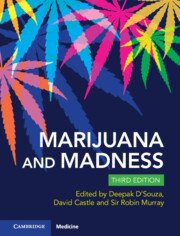167 results
CAN THE UK ACHIEVE NET ZERO GREENHOUSE GAS EMISSIONS BY 2050?
-
- Journal:
- National Institute Economic Review ,
- Published online by Cambridge University Press:
- 22 May 2024, pp. 1-11
-
- Article
-
- You have access
- Open access
- HTML
- Export citation
Medical assistance in dying for mental illness: a complex intervention requiring a correspondingly complex evaluation approach
-
- Journal:
- The British Journal of Psychiatry , FirstView
- Published online by Cambridge University Press:
- 04 March 2024, pp. 1-4
-
- Article
-
- You have access
- Open access
- HTML
- Export citation
Aggressive behaviours associated with MDMA and psychedelics: a narrative review
-
- Journal:
- Acta Neuropsychiatrica , First View
- Published online by Cambridge University Press:
- 08 February 2024, pp. 1-13
-
- Article
-
- You have access
- Open access
- HTML
- Export citation
Psilocybin for treatment-resistant depression without psychedelic effects: study protocol for a 4-week, double-blind, proof-of-concept randomised controlled trial
-
- Journal:
- BJPsych Open / Volume 9 / Issue 4 / July 2023
- Published online by Cambridge University Press:
- 25 July 2023, e134
-
- Article
-
- You have access
- Open access
- HTML
- Export citation
Contributors
-
- Book:
- Marijuana and Madness
- Published online:
- 12 May 2023
- Print publication:
- 01 June 2023, pp vii-x
-
- Chapter
- Export citation
Chapter 24 - Treating Cannabis Use in Schizophrenia and Other Psychotic Disorders
- from Part VII - Cannabinoids and Schizophrenia: Aetiopathology and Treatment Implications
-
-
- Book:
- Marijuana and Madness
- Published online:
- 12 May 2023
- Print publication:
- 01 June 2023, pp 246-266
-
- Chapter
- Export citation
Index
-
- Book:
- Marijuana and Madness
- Published online:
- 12 May 2023
- Print publication:
- 01 June 2023, pp 357-366
-
- Chapter
- Export citation
Part V - Cannabis and Psychosis
-
- Book:
- Marijuana and Madness
- Published online:
- 12 May 2023
- Print publication:
- 01 June 2023, pp 139-166
-
- Chapter
- Export citation
Part II - The Changing Face of Cannabis
-
- Book:
- Marijuana and Madness
- Published online:
- 12 May 2023
- Print publication:
- 01 June 2023, pp 31-60
-
- Chapter
- Export citation
Copyright page
-
- Book:
- Marijuana and Madness
- Published online:
- 12 May 2023
- Print publication:
- 01 June 2023, pp iv-iv
-
- Chapter
- Export citation
Part VII - Cannabinoids and Schizophrenia: Aetiopathology and Treatment Implications
-
- Book:
- Marijuana and Madness
- Published online:
- 12 May 2023
- Print publication:
- 01 June 2023, pp 225-266
-
- Chapter
- Export citation
Part IV - Cannabis, Anxiety, and Mood
-
- Book:
- Marijuana and Madness
- Published online:
- 12 May 2023
- Print publication:
- 01 June 2023, pp 107-138
-
- Chapter
- Export citation
Part VIII - Special Topics
-
- Book:
- Marijuana and Madness
- Published online:
- 12 May 2023
- Print publication:
- 01 June 2023, pp 267-356
-
- Chapter
- Export citation
Part III - Cannabis and the Brain
-
- Book:
- Marijuana and Madness
- Published online:
- 12 May 2023
- Print publication:
- 01 June 2023, pp 61-106
-
- Chapter
- Export citation
Part VI - Cannabinoids and Schizophrenia: Aetiopathology and Treatment Implications
-
- Book:
- Marijuana and Madness
- Published online:
- 12 May 2023
- Print publication:
- 01 June 2023, pp 167-224
-
- Chapter
- Export citation
Contents
-
- Book:
- Marijuana and Madness
- Published online:
- 12 May 2023
- Print publication:
- 01 June 2023, pp v-vi
-
- Chapter
- Export citation
Part I - Pharmacology of Cannabis and the Endocannabinoid System
-
- Book:
- Marijuana and Madness
- Published online:
- 12 May 2023
- Print publication:
- 01 June 2023, pp 1-30
-
- Chapter
- Export citation
Preface
-
- Book:
- Marijuana and Madness
- Published online:
- 12 May 2023
- Print publication:
- 01 June 2023, pp xi-xii
-
- Chapter
- Export citation

Marijuana and Madness
-
- Published online:
- 12 May 2023
- Print publication:
- 01 June 2023
Interventions for mental health, cognition, and psychological wellbeing in long COVID: a systematic review of registered trials
-
- Journal:
- Psychological Medicine / Volume 52 / Issue 13 / October 2022
- Published online by Cambridge University Press:
- 30 June 2022, pp. 2426-2440
-
- Article
-
- You have access
- Open access
- HTML
- Export citation



